-
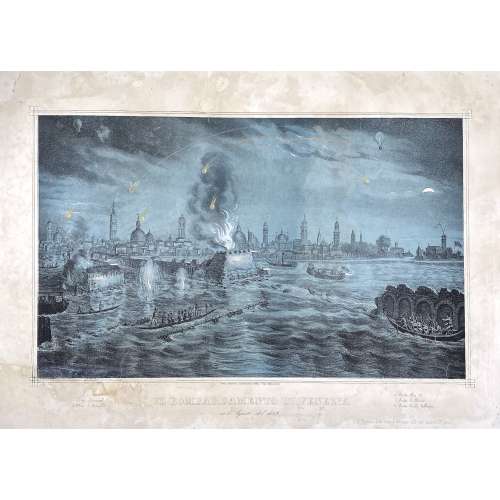 Quaritch's description: Single sheet (435 x 625 mm); coloured lithograph by Kirchmayr after a drawing by M. Fontana; hand-painted details; signed to lower left ‘M. Fon[tana]’ and to lower right ‘M. Fontana Edit. Prop. S. Giacomo dall’Orio in Isola N°.1481’; lower margin with the title ‘Il bombardamento di Venezia nell’Agosto 1849’ and key; restored tears in many places, especially along upper and lower blank margins, some affecting print; losses to lower left corner, affecting a small portion of the print, ruled border, and key, restored and re-drawn where needed; loss to the upper left corner of blank margin; two small areas of restoration to the centre of upper blank margin; the whole sheet backed; nevertheless a remarkable survival. Exceedingly rare and striking lithograph of Venice as seen from Fusina, depicting the first ever aerial bombardment in history. The bombardment took place in 1849, under the orders of Field Marshal Josef Radetzky (1766–1858), to quell the revolts that had started the previous year during the First Italian War of Independence. This curious and little-known action was the brainchild of Colonel Benno Uchatius, a brilliant young officer in the Austro-Hungarian Artillery. After long months of unsuccessful siege, Uchatius decided to deploy an unusual weapon: a hot air balloon able to bomb the city from above. Having calculated the wind speed and direction and evaluated the requisite dimensions of the hot-air balloon, Uchatius set up a workshop near Mestre, where a group of engineers and craftsmen began to manufacture a balloon equipped with a large wicker basket which could transport two crewmen and approximately one hundred kilograms of small long-fuse devices (metal spheres filled with gunpowder, pitch, oil and five hundred rifle buckshot). The initial trials, however, proved to be a disaster, because the balloon would drift off course, making it impossible to accurately deploy the bombs. Uchatius then hit upon the idea of using several smaller unmanned balloons roped together. These were to be launched over the city and, using the position of the first ‘pilot’ balloon, which was unarmed, the Austrians could calculate the correct fuse settings for the bombs. The ‘bomber’ balloons had a cloth envelope of one hundred cubic metres and a reduced load of about twenty kilograms of ordnance. According to Uchatius’ calculations, the line of balloons, launched from Mestre, would reach the lagoon city in thirty-five to forty minutes, carried by the north-west wind. In July 1849, a first launch was attempted, but when a breeze began to blow from the sea some of the balloons broke the connecting ropes and floated away, while others settled in the water in front of the northern part of the city, where a curious crowd of Venetians observed the failure of the enterprise and commented colourfully on the ‘buffoonery of Radetzky’. Uchatius’ second attempt, which is depicted in this lithograph, was also largely unsuccessful: only a few of the unmanned bomber balloons reached their target, and some even drifted back over the Austrian lines. Uchatius, having accomplished the first ever aerial bombardment, and having designed the first ever military ‘drones’, was forced to abandon the project permanently. Another fascinating aspect of this work is the vantage point used to depict the city of Venice, seen here from Fusina, a very rare viewpoint that makes this piece even more remarkable. We were unable to locate any copies in any institution or bibliography. G. Kirchmayr (fl. mid-19th century) is mentioned at British Museum database as "Lithographer active in Venice; related to Venetian painter Cherubino Kirchmayr (b. 1848)?" However, I was not able to find that name on the print. Not much is known of M. Fontana either.
Quaritch's description: Single sheet (435 x 625 mm); coloured lithograph by Kirchmayr after a drawing by M. Fontana; hand-painted details; signed to lower left ‘M. Fon[tana]’ and to lower right ‘M. Fontana Edit. Prop. S. Giacomo dall’Orio in Isola N°.1481’; lower margin with the title ‘Il bombardamento di Venezia nell’Agosto 1849’ and key; restored tears in many places, especially along upper and lower blank margins, some affecting print; losses to lower left corner, affecting a small portion of the print, ruled border, and key, restored and re-drawn where needed; loss to the upper left corner of blank margin; two small areas of restoration to the centre of upper blank margin; the whole sheet backed; nevertheless a remarkable survival. Exceedingly rare and striking lithograph of Venice as seen from Fusina, depicting the first ever aerial bombardment in history. The bombardment took place in 1849, under the orders of Field Marshal Josef Radetzky (1766–1858), to quell the revolts that had started the previous year during the First Italian War of Independence. This curious and little-known action was the brainchild of Colonel Benno Uchatius, a brilliant young officer in the Austro-Hungarian Artillery. After long months of unsuccessful siege, Uchatius decided to deploy an unusual weapon: a hot air balloon able to bomb the city from above. Having calculated the wind speed and direction and evaluated the requisite dimensions of the hot-air balloon, Uchatius set up a workshop near Mestre, where a group of engineers and craftsmen began to manufacture a balloon equipped with a large wicker basket which could transport two crewmen and approximately one hundred kilograms of small long-fuse devices (metal spheres filled with gunpowder, pitch, oil and five hundred rifle buckshot). The initial trials, however, proved to be a disaster, because the balloon would drift off course, making it impossible to accurately deploy the bombs. Uchatius then hit upon the idea of using several smaller unmanned balloons roped together. These were to be launched over the city and, using the position of the first ‘pilot’ balloon, which was unarmed, the Austrians could calculate the correct fuse settings for the bombs. The ‘bomber’ balloons had a cloth envelope of one hundred cubic metres and a reduced load of about twenty kilograms of ordnance. According to Uchatius’ calculations, the line of balloons, launched from Mestre, would reach the lagoon city in thirty-five to forty minutes, carried by the north-west wind. In July 1849, a first launch was attempted, but when a breeze began to blow from the sea some of the balloons broke the connecting ropes and floated away, while others settled in the water in front of the northern part of the city, where a curious crowd of Venetians observed the failure of the enterprise and commented colourfully on the ‘buffoonery of Radetzky’. Uchatius’ second attempt, which is depicted in this lithograph, was also largely unsuccessful: only a few of the unmanned bomber balloons reached their target, and some even drifted back over the Austrian lines. Uchatius, having accomplished the first ever aerial bombardment, and having designed the first ever military ‘drones’, was forced to abandon the project permanently. Another fascinating aspect of this work is the vantage point used to depict the city of Venice, seen here from Fusina, a very rare viewpoint that makes this piece even more remarkable. We were unable to locate any copies in any institution or bibliography. G. Kirchmayr (fl. mid-19th century) is mentioned at British Museum database as "Lithographer active in Venice; related to Venetian painter Cherubino Kirchmayr (b. 1848)?" However, I was not able to find that name on the print. Not much is known of M. Fontana either. -
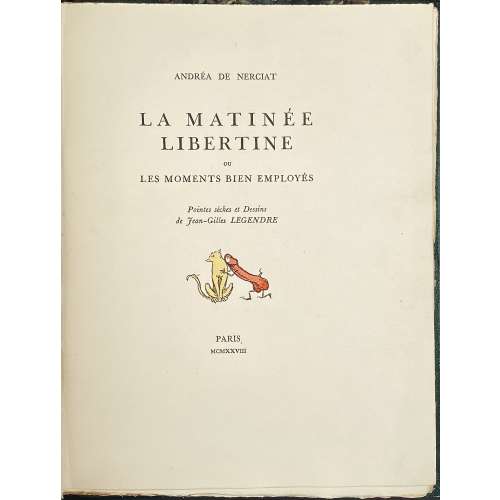 Front wrapper: LA MATINÉE | {vignette} | LIBERTINE || Title-page: ANDRÉA DE NERCIAT | LA MATINÉE | LIBERTINE | OU LES MOMENTS BIEN EMPLOYÉS | Pointes sèches et Dessins | de Jean-Gilles LEGENDRE | {fleuron in colour} | PARIS | MCMXXVIII || Description: Owner’s ¾ green morocco over marbled boards, raised bands, gilt lettering to spine, 24.3 x 19 cm overall, 23 x 17.5 cm leaves, green marbled endpapers, printed on BFK Rives watermarked wove paper. Collation: Orig. wrapper, [1-4] 2 blank leaves, [5-6] h.t. / limitation, [7-8] t.p. / blank, [9-10] avant-propos / blank, [11] 12-118, 4 blank leaves, orig. spine, orig. back wrapper, 9 hand-coloured dry-point plates with tissue guards, incl. engraved title/frontispiece, in-text colour illustrations (chromoxylography?). Limitation: A print run of 196 copies, № 1 on Vieux Japon, №№ 2-9 on Japon Impérial, №№ 10-21 on Hollande Van Gelder, and №№ 22-196 on Velin à la forme; this copy marked "H.C." (Horse Commerce") – not for sale (NFS), printed over the print run and reserved for the artist, other contributors, and their friends. Catalogue raisonné: Dutel (1920-1970): № 1939, p. 255: attributes publisher, and in-text illustration count; does not provide for H.C. copies in limitation. Contributors: André-Robert Andréa de Nerciat (French, 1739 – 1800) – author. Gaston Trilleau [pseud. Jean-Gilles Legendre] (French, 1874 – 1945) – illustrator. Maurice Henri Hector Duflou (French, 1885 – 1951) – publisher/printer.
Front wrapper: LA MATINÉE | {vignette} | LIBERTINE || Title-page: ANDRÉA DE NERCIAT | LA MATINÉE | LIBERTINE | OU LES MOMENTS BIEN EMPLOYÉS | Pointes sèches et Dessins | de Jean-Gilles LEGENDRE | {fleuron in colour} | PARIS | MCMXXVIII || Description: Owner’s ¾ green morocco over marbled boards, raised bands, gilt lettering to spine, 24.3 x 19 cm overall, 23 x 17.5 cm leaves, green marbled endpapers, printed on BFK Rives watermarked wove paper. Collation: Orig. wrapper, [1-4] 2 blank leaves, [5-6] h.t. / limitation, [7-8] t.p. / blank, [9-10] avant-propos / blank, [11] 12-118, 4 blank leaves, orig. spine, orig. back wrapper, 9 hand-coloured dry-point plates with tissue guards, incl. engraved title/frontispiece, in-text colour illustrations (chromoxylography?). Limitation: A print run of 196 copies, № 1 on Vieux Japon, №№ 2-9 on Japon Impérial, №№ 10-21 on Hollande Van Gelder, and №№ 22-196 on Velin à la forme; this copy marked "H.C." (Horse Commerce") – not for sale (NFS), printed over the print run and reserved for the artist, other contributors, and their friends. Catalogue raisonné: Dutel (1920-1970): № 1939, p. 255: attributes publisher, and in-text illustration count; does not provide for H.C. copies in limitation. Contributors: André-Robert Andréa de Nerciat (French, 1739 – 1800) – author. Gaston Trilleau [pseud. Jean-Gilles Legendre] (French, 1874 – 1945) – illustrator. Maurice Henri Hector Duflou (French, 1885 – 1951) – publisher/printer. -
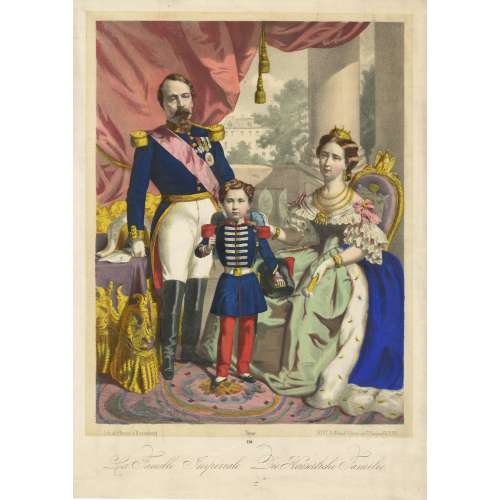 Hand-coloured lithography on wove paper, 395 x 280 mm; black ink stamp “5309” to reverse. On image: artist's initials "L. H."; on stone: "Lith. de Fr. Wentzel a Wissembourg. — Déposé — DÉPÔT, Fr. Wentzel Editeur rue St. Jacques 65, PARIS"; below centre: "239"; bottom : La famille Impériale. Die Kaizerliche Familie. Napoleon III [Charles-Louis Napoléon Bonaparte] (French, 1808 – 1873) Eugénie de Montijo [L'impératrice Eugénie] (Spanish-French, 1826 – 1920) Napoléon, Prince Imperial (Napoléon Eugène Louis Jean Joseph Bonaparte] (French, 1856 – 1879) Jean Frédéric Wentzel (French, 1807 – 1869) – publisher/printer.
Hand-coloured lithography on wove paper, 395 x 280 mm; black ink stamp “5309” to reverse. On image: artist's initials "L. H."; on stone: "Lith. de Fr. Wentzel a Wissembourg. — Déposé — DÉPÔT, Fr. Wentzel Editeur rue St. Jacques 65, PARIS"; below centre: "239"; bottom : La famille Impériale. Die Kaizerliche Familie. Napoleon III [Charles-Louis Napoléon Bonaparte] (French, 1808 – 1873) Eugénie de Montijo [L'impératrice Eugénie] (Spanish-French, 1826 – 1920) Napoléon, Prince Imperial (Napoléon Eugène Louis Jean Joseph Bonaparte] (French, 1856 – 1879) Jean Frédéric Wentzel (French, 1807 – 1869) – publisher/printer. -
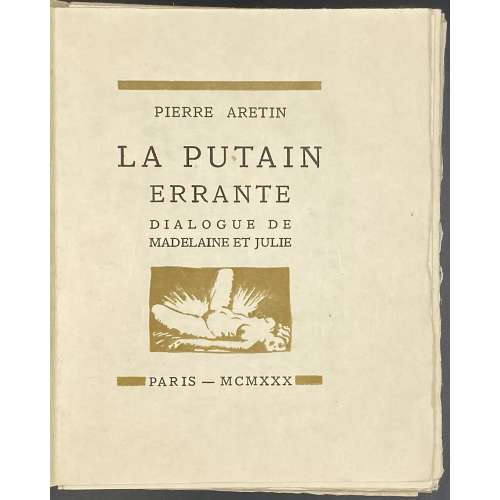 Title page (black lettering, gold elements of design): PIERRE ARETIN | LA PUTAIN | ERRANTE | DIALOGUE DE | MADELINE ET JULIE | {woodcut vignette} | PARIS — MCMXXX || Pagination: Red and gilt faux-marbled slipcase (19.5 x 15.5 cm), similar folder (18.7 x 15.1 cm), cream wove paper wrapper (18.5 x 14.7 cm) with gilt lettering “LA PUTAIN | ERRANTE”, with loosely inserted leaves printed on Japanese "mother-of-pearl" paper (japon nacré): [4] – blanks, [2] – h.t. / blank, [2] – t.p. / blank, 1-62, [2] – colophon / blank [4 blanks], gilt woodcut to p. 1; 76 pages total, plus 12 hand-coloured etchings (17.2 x 14.7 cm) by André Collot, extraneous to collation. Collation: 4to; π4, 1-84 χ2, 38 leaves total. Edition: 1st edition, limited to 150 copies, this is copy № 000009 (stamped in black ink). Catalogue raisonné: Dutel (1920-1970): № 2275, p. 333; Honesterotica. Contributors: Pietro Aretino (Italian, 1492 – 1556) – author (attributed). André Collot (French, 1897 – 1976) – artist.
Title page (black lettering, gold elements of design): PIERRE ARETIN | LA PUTAIN | ERRANTE | DIALOGUE DE | MADELINE ET JULIE | {woodcut vignette} | PARIS — MCMXXX || Pagination: Red and gilt faux-marbled slipcase (19.5 x 15.5 cm), similar folder (18.7 x 15.1 cm), cream wove paper wrapper (18.5 x 14.7 cm) with gilt lettering “LA PUTAIN | ERRANTE”, with loosely inserted leaves printed on Japanese "mother-of-pearl" paper (japon nacré): [4] – blanks, [2] – h.t. / blank, [2] – t.p. / blank, 1-62, [2] – colophon / blank [4 blanks], gilt woodcut to p. 1; 76 pages total, plus 12 hand-coloured etchings (17.2 x 14.7 cm) by André Collot, extraneous to collation. Collation: 4to; π4, 1-84 χ2, 38 leaves total. Edition: 1st edition, limited to 150 copies, this is copy № 000009 (stamped in black ink). Catalogue raisonné: Dutel (1920-1970): № 2275, p. 333; Honesterotica. Contributors: Pietro Aretino (Italian, 1492 – 1556) – author (attributed). André Collot (French, 1897 – 1976) – artist. -
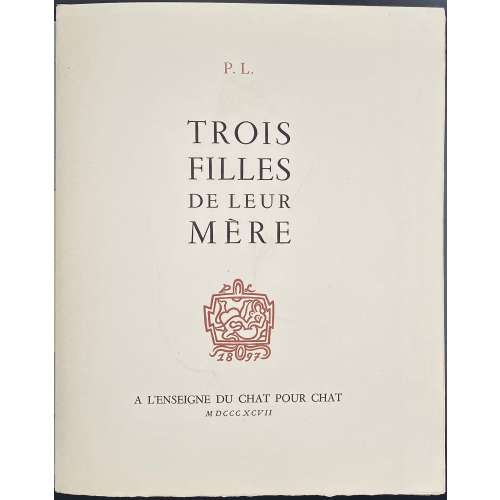 Description: Softcover, original blue-grey wrappers, maroon fleuron to front wrapper « P.L. {copulating couple} 1897. », 28.5 x 23 cm, in a grey double slipcase. Pp.: [1-10] 11-192 [2] [6 blanks], total 200 pages, 50 folio leaves folded in half collated in 4to, unbound, plus 16 coloured lithographs by Jean Berque; all printed on wove paper watermarked “LANA”. This is № 207 of an undisclosed number of copies. Edition enriched with a suite of 12 hand-coloured etchings after Éduard Chimot for publication in the late 1940s (Dutel 2524) on BFK Rives paper. Title-page (maroon and black): P. L. | TROIS | FILLES | DE LEUR | MÈRE | {fleuron} | A L'ENSEIGNE DU CHAT POUR CHAT | M DCCC XCVII || Catalogue raisonné: Dutel 2523, Pia 1340. Contributors: Pierre Louÿs (French, 1870 – 1925) – author. Jean Berque (French, 1896 – 1954) – artist. Édouard Chimot (French, 1880 – 1959) – artist.
Description: Softcover, original blue-grey wrappers, maroon fleuron to front wrapper « P.L. {copulating couple} 1897. », 28.5 x 23 cm, in a grey double slipcase. Pp.: [1-10] 11-192 [2] [6 blanks], total 200 pages, 50 folio leaves folded in half collated in 4to, unbound, plus 16 coloured lithographs by Jean Berque; all printed on wove paper watermarked “LANA”. This is № 207 of an undisclosed number of copies. Edition enriched with a suite of 12 hand-coloured etchings after Éduard Chimot for publication in the late 1940s (Dutel 2524) on BFK Rives paper. Title-page (maroon and black): P. L. | TROIS | FILLES | DE LEUR | MÈRE | {fleuron} | A L'ENSEIGNE DU CHAT POUR CHAT | M DCCC XCVII || Catalogue raisonné: Dutel 2523, Pia 1340. Contributors: Pierre Louÿs (French, 1870 – 1925) – author. Jean Berque (French, 1896 – 1954) – artist. Édouard Chimot (French, 1880 – 1959) – artist. -
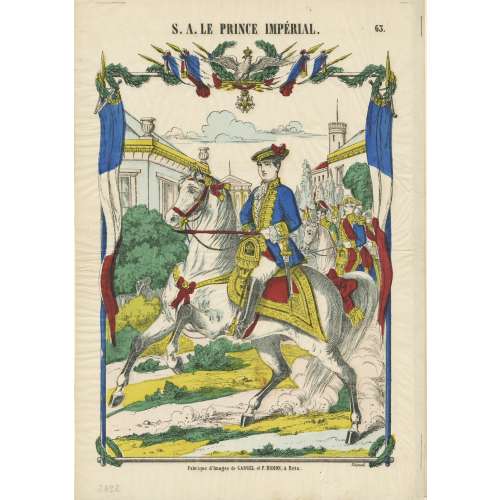 Hand-coloured woodcut on wove paper, 327 x 280 mm; black ink stamp “5265” to reverse, attached to the sheet 470 x 325 mm. Top centre: "S. A. LE PRINCE IMPÉRIAL.", right: "63." Image: equestiral portrait of Prince Impérial. Under the image, centre: "Fabrique d'Images de GANGEL et P. DIDION, à Metz." — "Déposé." Napoléon, Prince Imperial (Napoléon Eugène Louis Jean Joseph Bonaparte] (French, 1856 – 1879). Gangel et P. Didion (Metz); Paulin Didion (French, 1831 – 1879) – publisher/printer.
Hand-coloured woodcut on wove paper, 327 x 280 mm; black ink stamp “5265” to reverse, attached to the sheet 470 x 325 mm. Top centre: "S. A. LE PRINCE IMPÉRIAL.", right: "63." Image: equestiral portrait of Prince Impérial. Under the image, centre: "Fabrique d'Images de GANGEL et P. DIDION, à Metz." — "Déposé." Napoléon, Prince Imperial (Napoléon Eugène Louis Jean Joseph Bonaparte] (French, 1856 – 1879). Gangel et P. Didion (Metz); Paulin Didion (French, 1831 – 1879) – publisher/printer. -
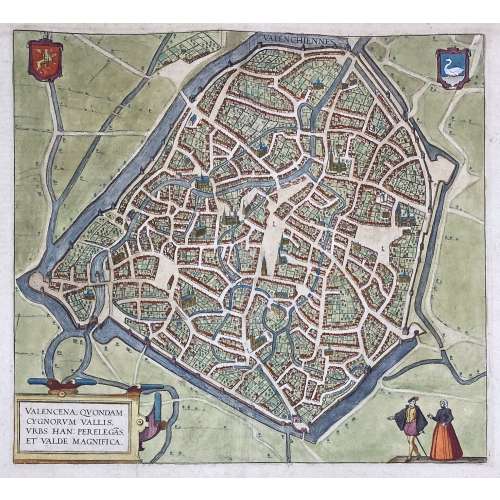 VALENCENA, QUONDAM | CYGNORUM VALLIS | URBS HAN: PERELEGÃS | ET VALDE MAGNIFICA. ||
VALENCENA, QUONDAM | CYGNORUM VALLIS | URBS HAN: PERELEGÃS | ET VALDE MAGNIFICA. ||Engraved and hand-coloured map of Valenciennes first produced for Braun & Hogenberg's 6-volume Civitates orbis terrarum edition in 1570.
English translation of the text printed on verso: "The Loire, an exceedingly well-known river in France, flows directly past the city and is very beneficial for trade. The fields surrounding the city are very fertile, and for this reason, the city is also called the granary throughout France, just as in earlier times Sicily was the granary of Rome. A famous wine also grows in this soil, which is exported from here not only throughout France but to all the countries in Europe. [...] The French spoken here is pure and uncorrupted, which is also the reason why so many foreigners settle here. For some are here for trade, others for study and others again to acquire the language, but also many without doubt for both these last two reasons, [...] and Germans, in particular, send their children here." [by Barry Lawrence Ruderman Antique Maps Inc.]
Dimensions: Sheet: 39.8 x 53.5 cm; Image: 35.2 x 38.5 cm.
Probably published in Cologne is 1612-18 by Petrum à Brachel: [Coloniae Agrippinae: apud Petrum à Brachel, sumptibus auctorum, 1612-1618]. Ref: LOC.Georg Braun [Brunus; Bruin] (German, 1541 – 1622).
Frans Hogenberg (Flemish-German, 1535 – 1590).
Abraham Ortelius [Ortels; Orthellius; Wortels] (Dutch, 1527 – 1598). -
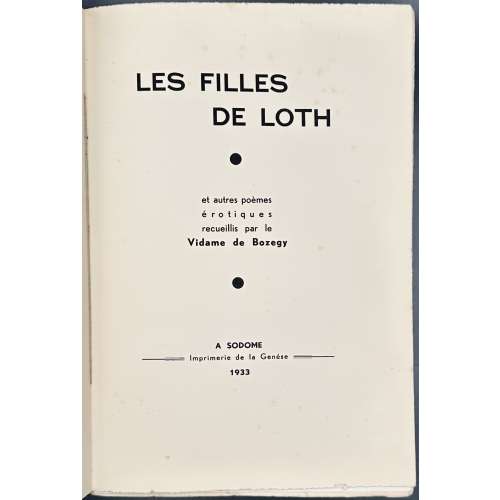 Softcover, french flapped wrappers, 29 x 19 cm, in glassine dustjacket, text printed on laid paper, pp.: [1-10] 11-256 [8], total 264 pages plus 11 plates out of 12, hand-coloured etchings on wove paper laid in, extraneous to collation. Wrappers detached from the block. Some pages uncut. Below is the missing plate, according to honesterotica.com:
Softcover, french flapped wrappers, 29 x 19 cm, in glassine dustjacket, text printed on laid paper, pp.: [1-10] 11-256 [8], total 264 pages plus 11 plates out of 12, hand-coloured etchings on wove paper laid in, extraneous to collation. Wrappers detached from the block. Some pages uncut. Below is the missing plate, according to honesterotica.com: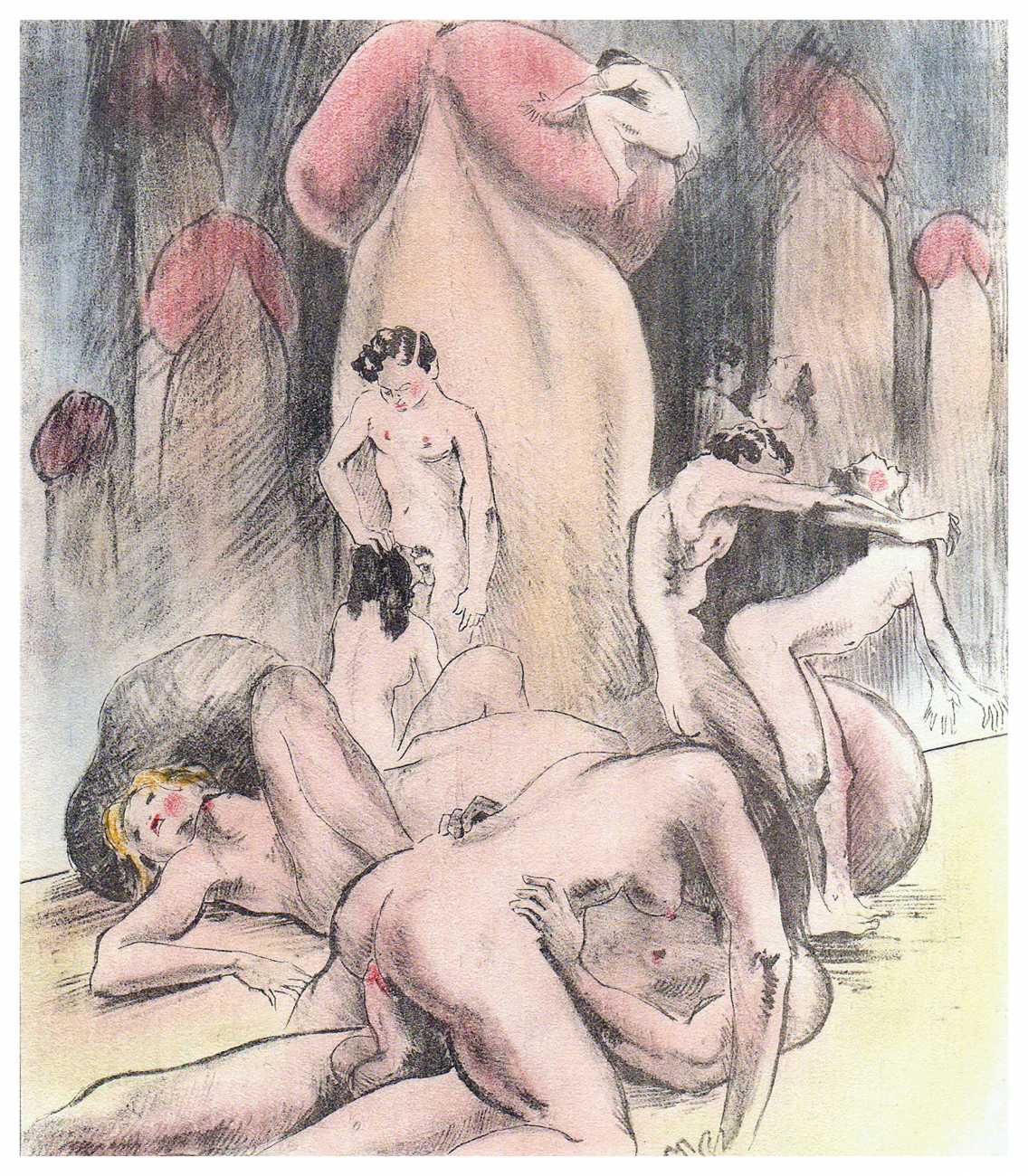 Title-page: LES FILLES | DE LOTH | • | et autres poèmes | érotiques | recueillis par le | Vidame de Bozegy | • | A SODOME | — Imprimerie de la Genèse — | 1933 ||
Edition limited to 500 copies, this is copy № 54.
Catalogue raisonné: Dutel III № 1575.
Edmond Dardenne Bernard [Vidame de Bozegy] (French, 20th c.) – author.
André Collot (French, 1897 – 1976) – artist.
Title-page: LES FILLES | DE LOTH | • | et autres poèmes | érotiques | recueillis par le | Vidame de Bozegy | • | A SODOME | — Imprimerie de la Genèse — | 1933 ||
Edition limited to 500 copies, this is copy № 54.
Catalogue raisonné: Dutel III № 1575.
Edmond Dardenne Bernard [Vidame de Bozegy] (French, 20th c.) – author.
André Collot (French, 1897 – 1976) – artist. -
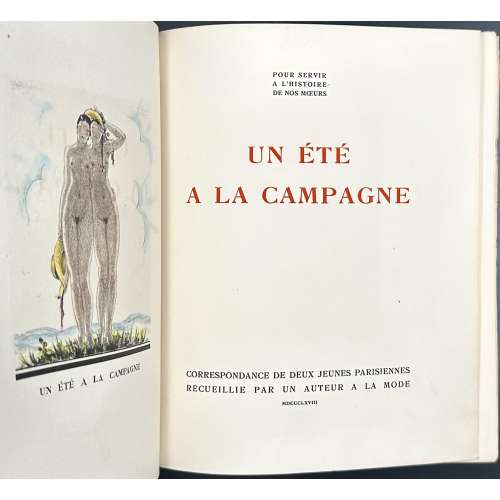 Softcover, 228 x 180 mm, tan French flapped wrappers with red lettering to front[1-4, owner’s glassine dustcover, top edge trimmed, printed on thick wove paper without a watermark; pp.: ffl [1-4 h.t., t.p.] 5-154 [2 blanks] colophon to back ffl recto, plus 12 plates with hand-coloured lithographs, extraneous to collation. Pencil and pigment drawing to h.t. signed “J. D’A” with gift manual inscription “A Monsieur et Madame Chalamel [sic] ce tardif mais sincère souvenir de sympathie”, signed “J et Y D’A.” Etching bookplate to front ffl recto: “EX LIBRIS PIERRE CHALLAMEL | JE FONCE DANS LE BROUILLARD”, signed “J A M” (Jean-Adrien Mercier). The signature J. D’A stands for Jean d’Angers, while Y D’A stands for Jean-Adrien’s wife Yvonne (1902—1999), nicknamed Zizi; they married in 1927. According to J.-P. Dutel, the stated illustrator of this edition, Jean d’Angers is indeed Jean-Adrien Mercier. The text belongs to Gustav Droz and, possibly, Auguste Poulet-Malassis. Limitation: the book was printed for subscribers in 30 copies on Japon Impériale paper (№№ 1-30) and 250 copies on vélin du Marais paper (№№ 31-280). This copy bears № 123 and was presented as a gift by the artist and his wife to Pierre Challamel. Title-page (red and black): POUR SERVIR | A L'HISTOIRE | DE NOS MŒURS | UN ÉTÉ | A LA CAMPAGNE | CORRESPONDANCE DE DEUX JEUNES PARISIENNES | RECUEILLIE PAR UN AUTEUR A LA MODE | MDCCCLXVIII || Catalogue raisonné: Dutel III № 2546; honesterotica. Provenance: Pierre Challamel (French, 20th century) Contributors: Gustave Droz (French, 1832 – 1895) – author (presumable). Auguste Poulet-Malassis (French, 1825 – 1878) – author (presumable). Jean-Adrien Mercier (French, 1899 – 1995) – artist. Micro photo of the lithography:
Softcover, 228 x 180 mm, tan French flapped wrappers with red lettering to front[1-4, owner’s glassine dustcover, top edge trimmed, printed on thick wove paper without a watermark; pp.: ffl [1-4 h.t., t.p.] 5-154 [2 blanks] colophon to back ffl recto, plus 12 plates with hand-coloured lithographs, extraneous to collation. Pencil and pigment drawing to h.t. signed “J. D’A” with gift manual inscription “A Monsieur et Madame Chalamel [sic] ce tardif mais sincère souvenir de sympathie”, signed “J et Y D’A.” Etching bookplate to front ffl recto: “EX LIBRIS PIERRE CHALLAMEL | JE FONCE DANS LE BROUILLARD”, signed “J A M” (Jean-Adrien Mercier). The signature J. D’A stands for Jean d’Angers, while Y D’A stands for Jean-Adrien’s wife Yvonne (1902—1999), nicknamed Zizi; they married in 1927. According to J.-P. Dutel, the stated illustrator of this edition, Jean d’Angers is indeed Jean-Adrien Mercier. The text belongs to Gustav Droz and, possibly, Auguste Poulet-Malassis. Limitation: the book was printed for subscribers in 30 copies on Japon Impériale paper (№№ 1-30) and 250 copies on vélin du Marais paper (№№ 31-280). This copy bears № 123 and was presented as a gift by the artist and his wife to Pierre Challamel. Title-page (red and black): POUR SERVIR | A L'HISTOIRE | DE NOS MŒURS | UN ÉTÉ | A LA CAMPAGNE | CORRESPONDANCE DE DEUX JEUNES PARISIENNES | RECUEILLIE PAR UN AUTEUR A LA MODE | MDCCCLXVIII || Catalogue raisonné: Dutel III № 2546; honesterotica. Provenance: Pierre Challamel (French, 20th century) Contributors: Gustave Droz (French, 1832 – 1895) – author (presumable). Auguste Poulet-Malassis (French, 1825 – 1878) – author (presumable). Jean-Adrien Mercier (French, 1899 – 1995) – artist. Micro photo of the lithography:
Micro photo of the original drawing: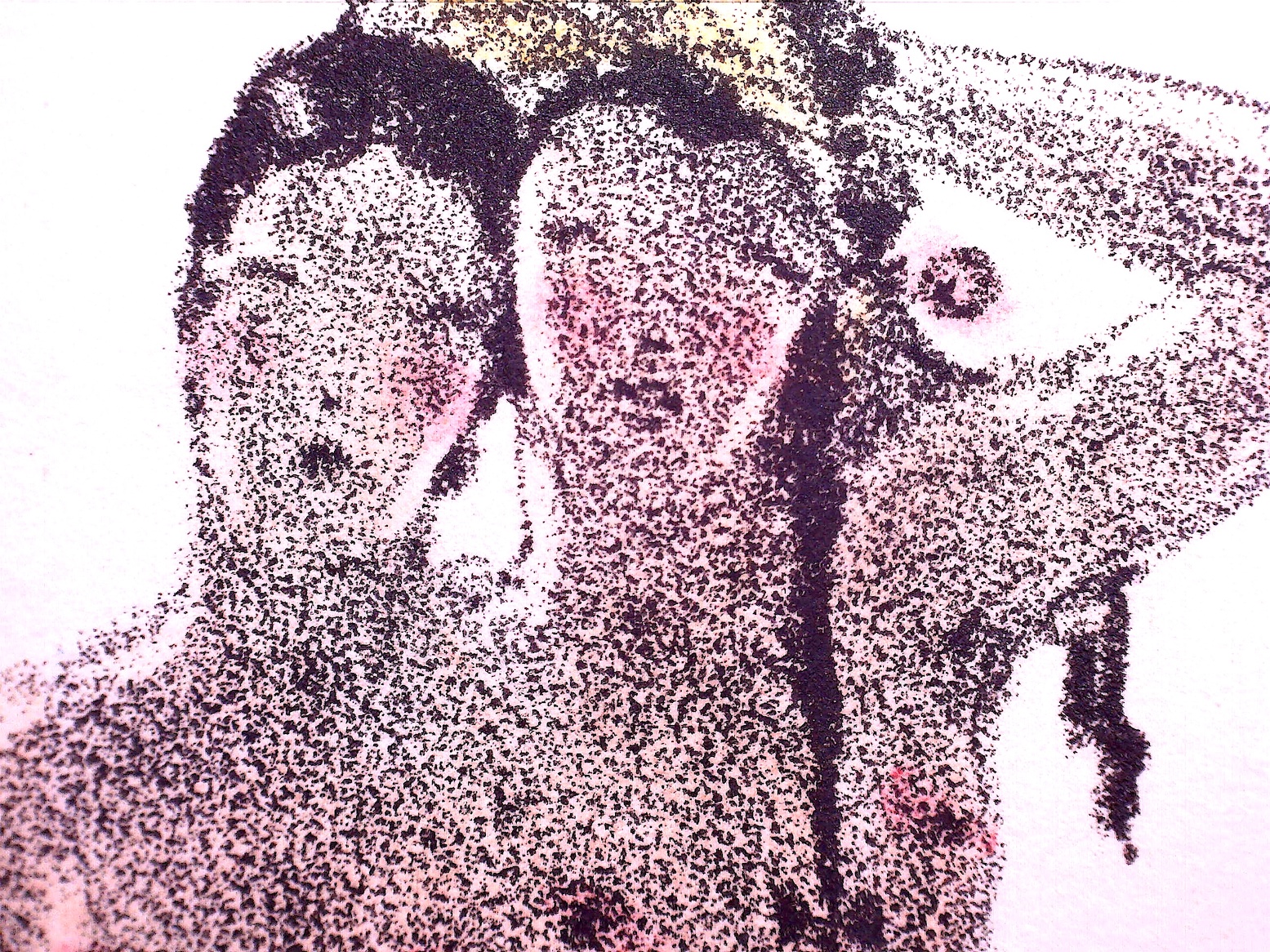
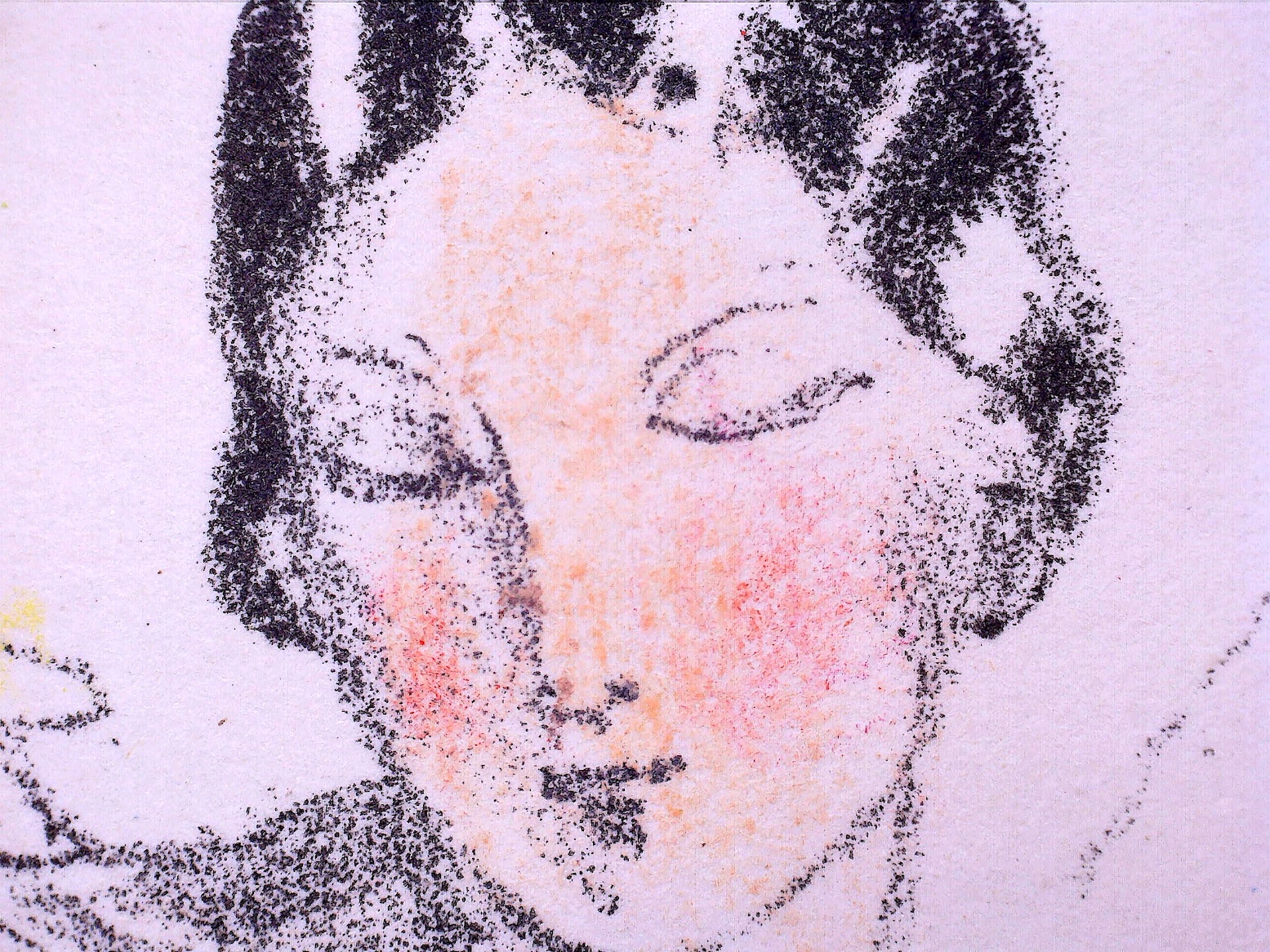
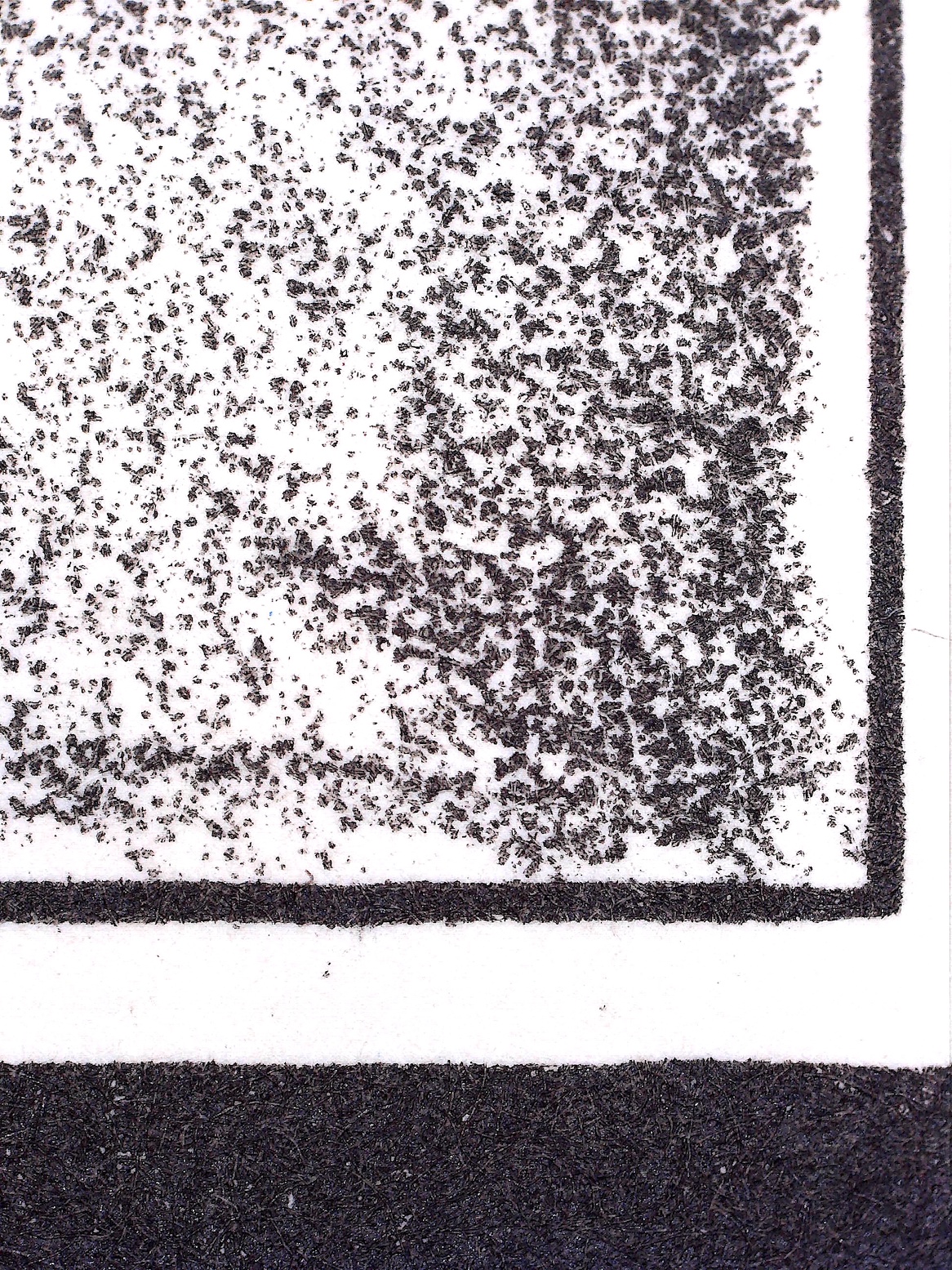
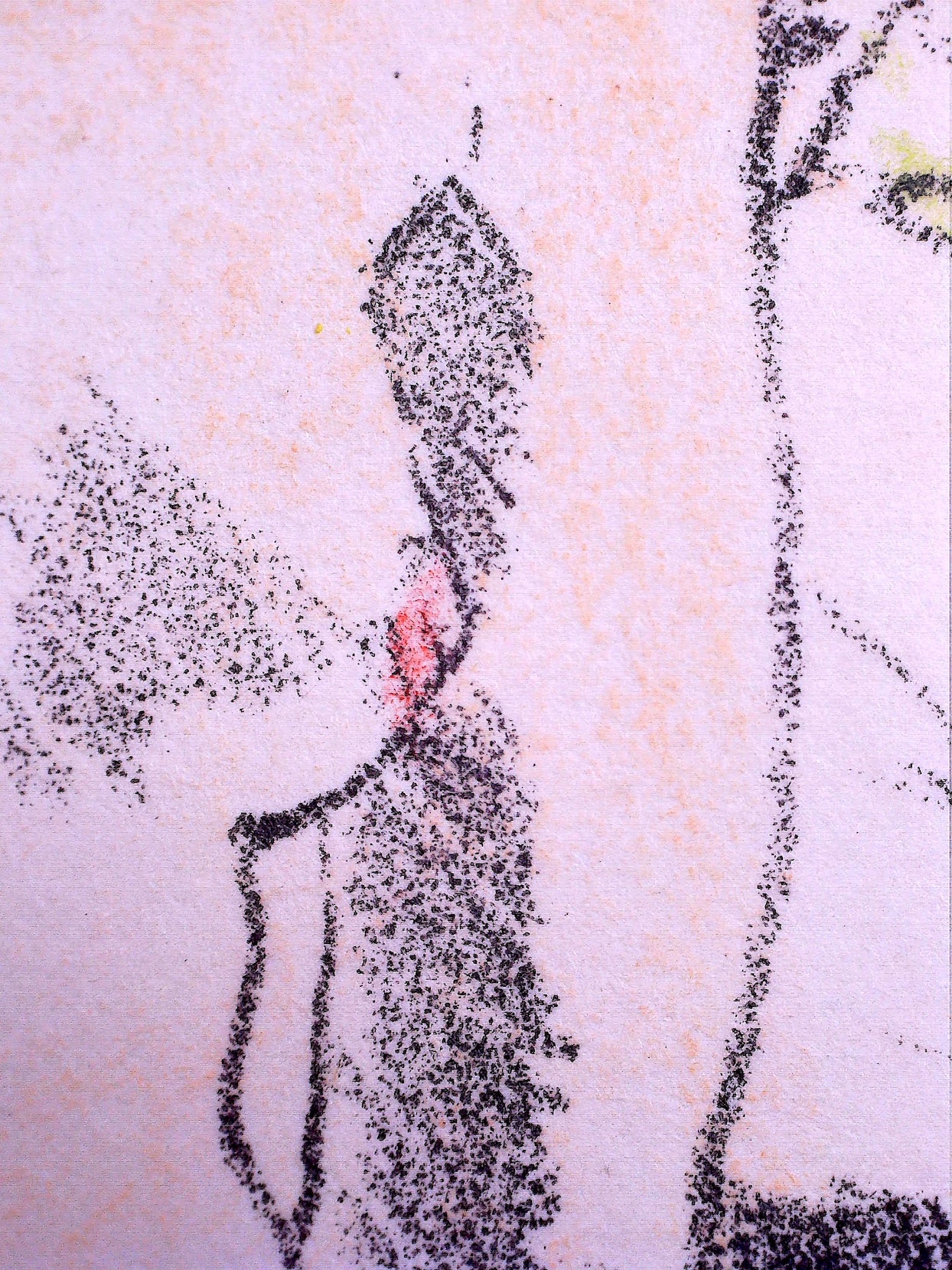
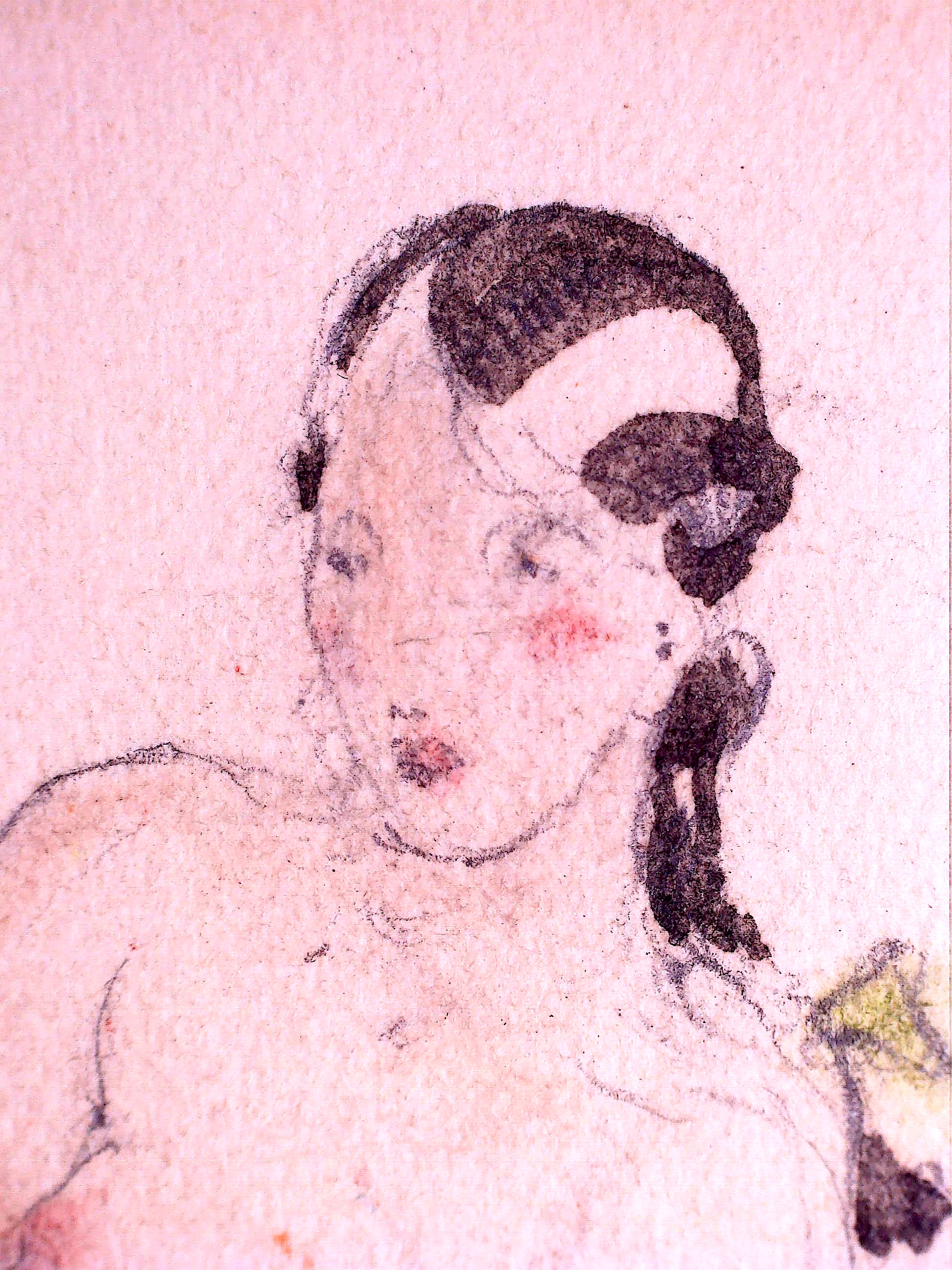
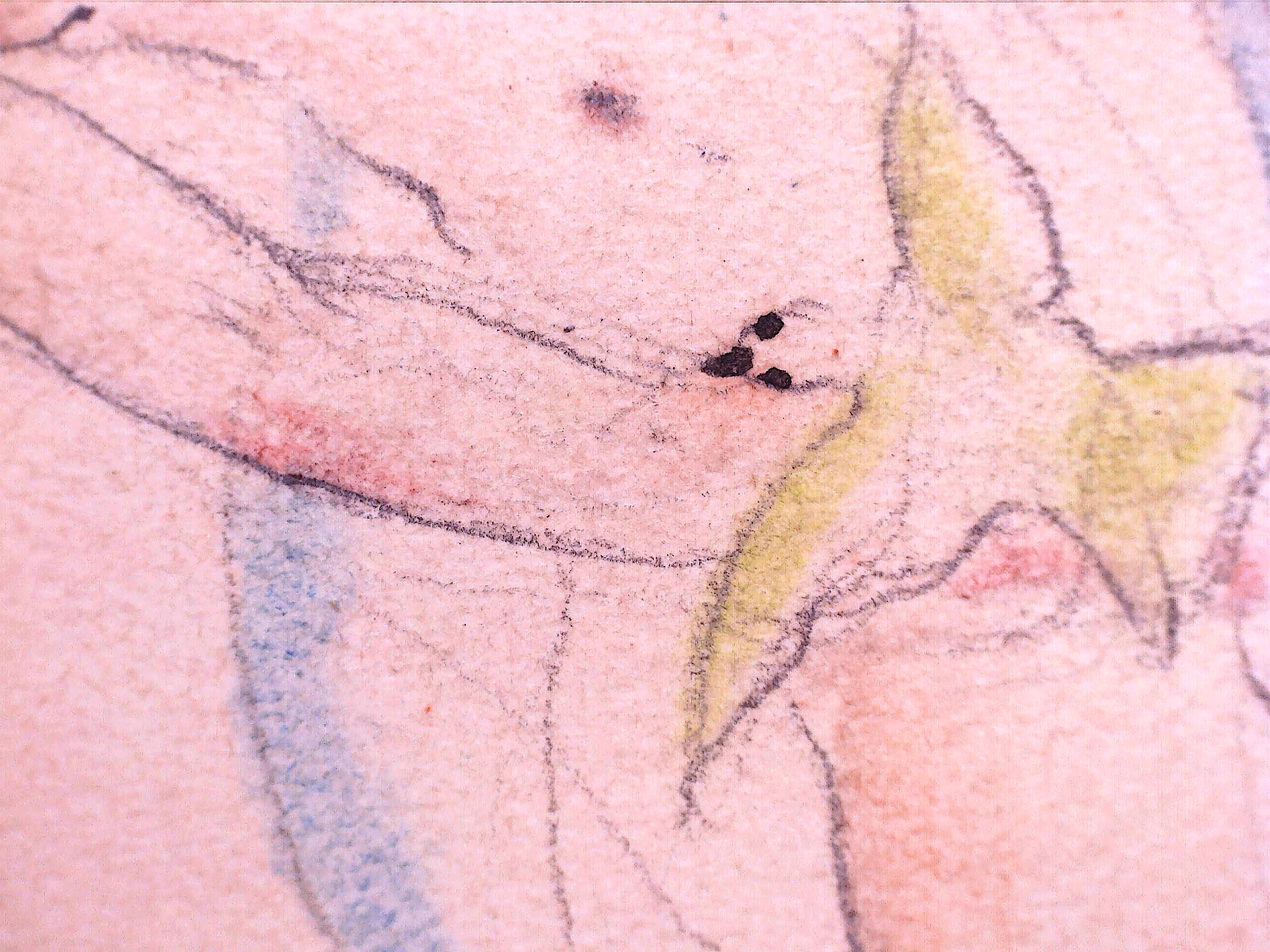
-
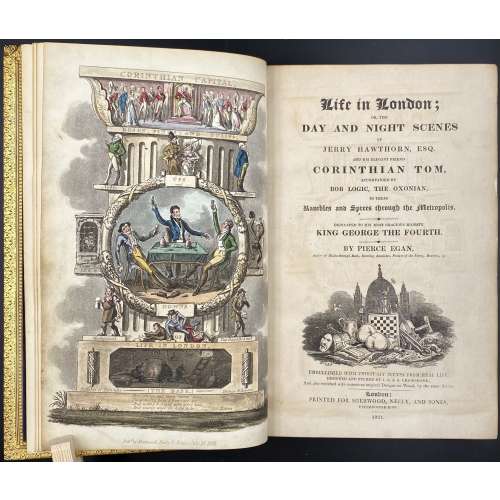
Title: Life in London ; | DAY AND NIGHT SCENES | OF | JERRY HAWTHORN, ESQ. | AND HIS ELEGANT FRIEND | CORINTHIAN TOM, | ACCOMPANIED BY | BOB LOGIC, THE OXONIAN, | IN THEIR |Rambles and Sprees through the Metropolis. | DEDICATED TO HIS MOST GRACIOUS MAJESTY | KING GEORGE THE FOURTH. | BY PIERCE EGAN, | Author of Walks through Bath, Sporting Anecdotes, Picture of the Fancy, Boxiana, &c. | [Vignette] | EMBELLISHED WITH THIRTY-SIX SCENES FROM REAL LIFE, | DESIGNED AND ETCHED BY I. R. & G. CRUIKSHANK ; | And also enriched with numerous original Designs on Wood, by the same Artists, | London: | PRINTED FOR SHERWOOD, NEELY, AND JONES, | PATERNOSTER-ROW. | 1821. ||
Edition: 1st edition, 1st issue: the first sheet of music is not numbered, absence of any footnote at page 9 (as per Cohn).
Pagination: 3 binder's flyleaves with a specimen of George Cruikshank's signature of Nov. 5th, 1860 to the first one; hand-coloured aquatint frontispiece facing the title page with blank recto, [iii-iv] – t.p. with vignette/ blank, [v] vi-viii – dedication, ix-xii – contents, [xiii]-xvi – list of illustrations; [1] 2-376; 35 hand-coloured aquatints, 3 folding leaves of music; bound without half-title [missing pp. i, ii], advertisements or 'to the subscribers' leaf.
Collation: 8vo; [A]7 B-Z8 Aa8-Bb4.
Binding: Full polished calf gilt by Rivière & Son, covers with triple gilt border, spine in 6 compartments, brown morocco lettering pieces to second and third, others richly gilt, raised bands, all edges gilt; neatly re-backed preserving spine.
Catalogue raisonné: Albert M. Cohn, 1924: № 262 p. 90; Abbey, J. R. (Life in England), 281; Tooley (Some English Books with Coloured Plates) 196; Prideaux (Aquatint Engraving) pp. 307, 310; Hardie (English coloured books) 197.
Description of Shapero Rare Books, London: There was a translation into French. At least six plays were based on Egan's characters, contributing to yet more sales. One of these was exported to America, launching the Tom and Jerry craze there. The version created by William Thomas Moncrieff was praised as The Beggar's Opera of its day. Moncrieff's production of Tom and Jerry, or Life in London ran continuously at the Adelphi Theatre for two seasons and it was the dramatist's work as much as the author's that did so much to popularise the book's trademark use of fashionable slang. In 1821 Egan announced the publication of a regular journal: Life in London, appearing monthly at a shilling a time. It was to be illustrated by George Cruikshank (1792 – 1878), and was dedicated to the King, George IV, who at one time had received Egan at court. The first edition of Life in London appeared on 15 July 1821. Egan's creation was an instant success. Pirate versions appeared, featuring such figures as 'Bob Tallyho', 'Dick Wildfire' and the like. Printmakers speedily knocked off cuts featuring the various 'stars' and the real-life public flocked to the 'sporting' addresses that Egan had his heroes frequent. -
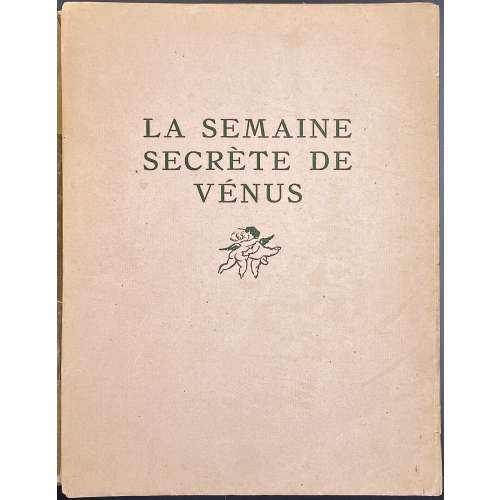 Description: Publisher’s tan French flapped wrappers, in glassine DJ, 25.4 x 19.4 cm, collated in-4to, lettered LA SEMAINE | SECRÈTE DE | VÉNUS | {fleuron} ||, outer margin uncut. Title-page: ≈ | LA SEMAINE | SECRÈTE | DE VÉNUS | Illustrée de huit Dessins | originaux reproduits en | lithographie et coloriés | {vignette} | LA CHRONIQUE CLANDESTINE | ≈ de 1919 à 1925 ≈ || Limitation: Unique copy on Vieux Japon enriched with original drawings and suites of plates, № 1-25 on Japon Imperial, enriched with 1 drawing and 3 suites of plates, № 26-275 on vélin d’Arches «avec les sept lithos en couleurs»; total print run – 275+1. This is copy № 70. Collation: π3 (blank, h.t./limit., t.p.), 1-154 χ1, total 64 leaves plus 7 plates, lithographs after drawings by Marcel Vertès, extraneous to collation. Note: Eight lithographs stated in the title are 7 plates AND a vignette on the title page. Vokaer attributes the printer/publisher as "Imprimerie Daragnès" and the year of publication as 1925. Pagination: [6] 2 blanks, 2 h.t. / limit., 2 t.p., [1-2] 3-115 [7] ; total 128 pages plus ils. Catalogue raisonné: Dutel (1920-1970): № 2386; Pia (Enfer) 1317; Nordmann (1): 246; Vokaer (1967): 8, Contributors : Pierre Mac-Orlan (French, 1882 – 1970) – author. Marcel Vertès [Marcell Vértes] (Jewish-Hungarian-French, 1895 – 1961) – artist. Paul Cotinaud – publisher (per Dutel) Coulouma (Argenteuil) – printer (per Dutel).
Description: Publisher’s tan French flapped wrappers, in glassine DJ, 25.4 x 19.4 cm, collated in-4to, lettered LA SEMAINE | SECRÈTE DE | VÉNUS | {fleuron} ||, outer margin uncut. Title-page: ≈ | LA SEMAINE | SECRÈTE | DE VÉNUS | Illustrée de huit Dessins | originaux reproduits en | lithographie et coloriés | {vignette} | LA CHRONIQUE CLANDESTINE | ≈ de 1919 à 1925 ≈ || Limitation: Unique copy on Vieux Japon enriched with original drawings and suites of plates, № 1-25 on Japon Imperial, enriched with 1 drawing and 3 suites of plates, № 26-275 on vélin d’Arches «avec les sept lithos en couleurs»; total print run – 275+1. This is copy № 70. Collation: π3 (blank, h.t./limit., t.p.), 1-154 χ1, total 64 leaves plus 7 plates, lithographs after drawings by Marcel Vertès, extraneous to collation. Note: Eight lithographs stated in the title are 7 plates AND a vignette on the title page. Vokaer attributes the printer/publisher as "Imprimerie Daragnès" and the year of publication as 1925. Pagination: [6] 2 blanks, 2 h.t. / limit., 2 t.p., [1-2] 3-115 [7] ; total 128 pages plus ils. Catalogue raisonné: Dutel (1920-1970): № 2386; Pia (Enfer) 1317; Nordmann (1): 246; Vokaer (1967): 8, Contributors : Pierre Mac-Orlan (French, 1882 – 1970) – author. Marcel Vertès [Marcell Vértes] (Jewish-Hungarian-French, 1895 – 1961) – artist. Paul Cotinaud – publisher (per Dutel) Coulouma (Argenteuil) – printer (per Dutel). -
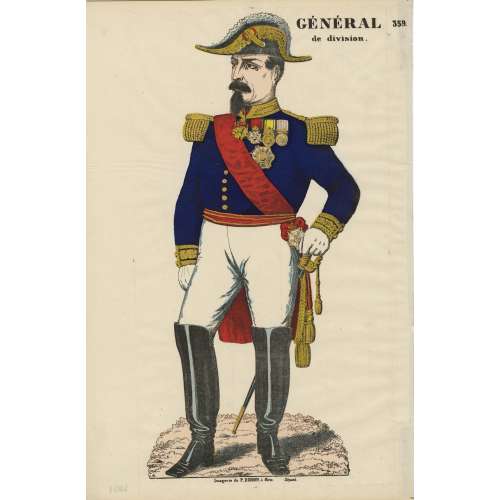 Hand-coloured woodcut on wove paper, 430 x 285 mm; black ink stamp “5051” to reverse. Top right: "GÉNÉRAL | de division." — "359." Bottom: "Imagerie de DIDION, à Metz. Déposé." Paulin Didion (French, 1831 – 1879) – publisher/printer.
Hand-coloured woodcut on wove paper, 430 x 285 mm; black ink stamp “5051” to reverse. Top right: "GÉNÉRAL | de division." — "359." Bottom: "Imagerie de DIDION, à Metz. Déposé." Paulin Didion (French, 1831 – 1879) – publisher/printer. -
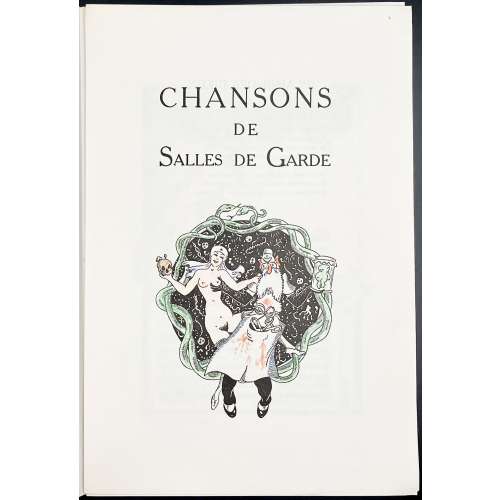 Title-page: CHANSONS | DE | SALLES DE GARDE | {vignette} || Description: 27.5 x 18.5 cm, in pictorial French flapped wrapper and in a green cloth folder, vertically lettered to spine “CHANSONS” in black letters, a flute benith. Pagination: [1-3] 4-140 [4] plus 52 plates extraneous to collation (Dutel provides for 142 pp.) Illustrations: plates, headbands, vignettes to front wrapper, title-page and limitation page, as well as the vignette at the end, reproduced after drawings by Morvan (according to J.-P. Dutel) and hand-coloured with crayons (the question remains, is it Hervé Morvan, French, 1917 – 1980?) Limitation: 950 copies of which 25 marked A to Z; 25 copies consist of an additional suite and one original drawing (№ 1-25); 25 copies have an original drawing (№ 26-50), and 875 copies numbered 51 to 950. This copy is № 697. Catalogue raisonné: Dutel (1920-1970): № 1186.
Title-page: CHANSONS | DE | SALLES DE GARDE | {vignette} || Description: 27.5 x 18.5 cm, in pictorial French flapped wrapper and in a green cloth folder, vertically lettered to spine “CHANSONS” in black letters, a flute benith. Pagination: [1-3] 4-140 [4] plus 52 plates extraneous to collation (Dutel provides for 142 pp.) Illustrations: plates, headbands, vignettes to front wrapper, title-page and limitation page, as well as the vignette at the end, reproduced after drawings by Morvan (according to J.-P. Dutel) and hand-coloured with crayons (the question remains, is it Hervé Morvan, French, 1917 – 1980?) Limitation: 950 copies of which 25 marked A to Z; 25 copies consist of an additional suite and one original drawing (№ 1-25); 25 copies have an original drawing (№ 26-50), and 875 copies numbered 51 to 950. This copy is № 697. Catalogue raisonné: Dutel (1920-1970): № 1186. -
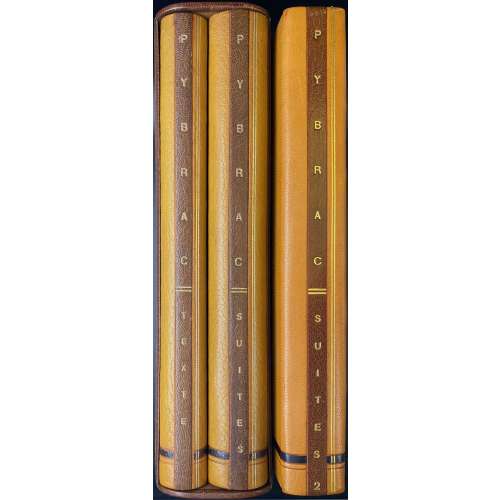 A three-volume unique copy of Louÿs’s poetical work ‘Pybrac’; edition published in 1928 by Marcel Vertès limited to 30 copies; contains 31 drypoints by Marcel Vertès, incl. frontispiece, nine full-page plates and twenty in-text vignettes; enriched with a volume of three suites of plates (first state b/w on Van Gelder paper, final state b/w on Japon nacré paper, final state hand-coloured on Van Gelder paper) plus 5 refused plates; and with a volume of one original watercolour, five ink drawings, three suites of plates (first state b/w on Van Gelder paper, final state b/w on Japon nacré paper, final state hand-coloured on Van Gelder paper) plus similar 5 refused plates, one b/w plate and one coloured plate, and a drypoint metal plate; two volumes of three are in a slipcase. Same edition in this collection: LIB-2919.2022. Details: (1) The ‘Texte’ volume, collated in-4to, 26 x 20.5 cm bound by Creuzevault (signed inside the front cover, in the bottom) in full tan morocco, blind fillets and a brown strip in the bottom to boards, double gilt fillet and a brown label along the spine, gilt-lettered vertically “PYBRAC | TEXTE”; gilt on black faux marbled endpapers, printed on watermarked Van Gelder Zonen laid paper; collated as follows: [3] blank flyleaves, [1] wrapper ‘PYBRAC’, [5] leaves with pasted original ink drawings on white paper, [1] leaf with pasted original hand-coloured ink drawings on blue paper, [1] drypoint frontispiece, [2] blank leaves, [1] half-title/limitation, [1] t.p., [2] blank leaves, 1-104 (pp. 1-78 [2]), [4] blank leaves plus nine full-page drypoint plates; total 70 leaves. Title-page: PYBRAC | ILLUSTRE DE TRENTE POINT SÈCHES | D’UN | ARTISTE INCONNU | PARIS | AUX DÉPENS D’UN AMATEUR | — | M. CM. XXVIII || Limitation: Edition limited to 30 copies; 1 copy unique on Japon Nacré with 30 original sketches, one suite in colour, two suites in black and 5 cancelled plates; 29 copies on Hollande Van Gelder, with one original watercolour, four original sketches, one suite in colour, two suites in black and 5 cancelled plates. This is copy № 12. (2) The ‘Suites’ volume, 26 x 20.5 cm, uniformly bound in quarter tan morocco over faux marbled paper, blind fillets, horizontal brown strip in the bottom, a vertical brown strip along the border, double gilt fillet and a brown label along the spine, gilt-lettered vertically “PYBRAC | SUITES”; gilt on black faux marbled endpapers; collated as follows: [3] blank flyleaves, three suites of prints: first state on Van Gelder paper, the final state on ‘Japon nacré’ paper, and hand-coloured final state on Van Gelder (31 x 3 = 93 leaves) plus [5] refused plates and [3] blank leaves; total 104 leaves. ‘Texte’ and ‘Suites’ volumes are placed in a faux marbled slipcase. (3) The ‘Suites 2’ volume, 26 x 21.5 cm, bound similarly to the ‘Suites’ volume (quarter morocco), gilt-lettered vertically “PYBRAC | SUITES 2” to spine; front cover with a hollow placement with the drypoint metal plate inside (plate #3), [3] blank wove paper leaves, [1] section title (s.t.) ‘AQUARELLE ORIGINALE’, [1] ink and crayon drawing, [1] s.t. ‘CROQUIS ORIGINAUX’, [5] ink drawings, [1] s.t. ‘PREMIER ÉTAT DES PLANCHES’, [31] plates on Van Gelder, [1] s.t. ‘SUITE EN NOIR SUR JAPON NACRÉ’, [31] plates, s.t. ‘SUITE COLORIÉE A LA MAIN’, [31] plates, [1] s.t. ‘PLANCHES REFUSÉS’, [5] plates, [1] coloured plate #13, [1] uncoloured plate #10, [3] wove paper blank leaves; total 118 leaves. Catalogue raisonné: Dutel (1920-70) № 2279 ; Fekete № 216; Nordmann (I) № 235; Vokaer 23. Ref.: honesterotica.com Contributors: Pierre Louÿs (French, 1870 – 1925) – author. Marcel Vertès [Marcell Vértes] (Jewish-Hungarian-French, 1895 – 1961) – artist. Henri Creuzevault (French, 1905 – 1971) – bookbinder. Seller's description: [ENRICHI & HORS-COMMERCE NON JUSTIFIÉ] Pierre LOUŸS - Marcel VERTÈS. Pybrac, illustré de trente pointes sèches d’un artiste inconnu. Paris, aux dépens d’un amateur, 1928. 3 volumes in-4 de 79 pages, 98 et 76 feuillets. Le volume contenant le texte est relié d'un plein chagrin havane à dos lisse, une pièce de titre en long et un filet doré à froid en bas (Creuzevault). Les deux autres volumes sont reliés à l'identiques, demi chagrin havane, dos lisse, pièce de titre en long, filets dorés sur le dos et filet doré à froid sur le bas et le long du mors. Le cuivre est placé dans le plat intérieur du volume 3, les suites dans le 2. Les deux premiers volumes sont rassemblés dans un étui. Illustré de 31 gravures originales dont 11 hors-texte par Marcel Vertès pour l’une des premières publications obscènes de Pierre Louÿs. Tirage à 30 exemplaires. La justification indique : "Il a été tiré de ce livre 30 exemplaires : 1 exemplaire unique sur Japon nacré avec trente croquis originaux, une suite en couleur, deux suites en noir et une épreuve des cinq planches refusées ; 29 exemplaires sur grand papier de Hollande Van Gelder avec une aquarelle originale, quatre croquis originaux, une suite en couleur, deux suites en noir et une épreuve des cinq planches refusées.". Exemplaire n°12 (Volume 1 Texte). Cet exemplaire est composé différemment soit : Volume 1, Texte : La couverture conservée, 5 dessins originaux à l'encre, 1 dessin sur papier bleu à l'estompe de couleur, le texte, les gravures in-texte et hors-texte. — Volume 2, Suites : les 31 planches en 3 états (1 en couleur et 2 en noir) et une épreuve des 5 planches refusées. — Volume 3, Suites 2 : 1 cuivre, 1 aquarelle, 5 dessins originaux à l'encre, 2 suites en noir, 1 suite coloriée à la main, 1 épreuve des 5 planches refusées, 1 dessin refusé à l'encre et à l'aquarelle et 1 dessin refusé à l'encre. Dutel précise : « Elle est ornée de 11 gravures originales hors-texte dont un titre et 20 gravures dans le texte par Marcel Vertès qui fut aussi l’éditeur de cet ouvrage. Il s’agit d’une des plus belles et des plus rares productions bibliophiliques de l’artiste. » Et surtout la plus rare… (Dutel 2279, pas à l’Enfer de la BnF).
A three-volume unique copy of Louÿs’s poetical work ‘Pybrac’; edition published in 1928 by Marcel Vertès limited to 30 copies; contains 31 drypoints by Marcel Vertès, incl. frontispiece, nine full-page plates and twenty in-text vignettes; enriched with a volume of three suites of plates (first state b/w on Van Gelder paper, final state b/w on Japon nacré paper, final state hand-coloured on Van Gelder paper) plus 5 refused plates; and with a volume of one original watercolour, five ink drawings, three suites of plates (first state b/w on Van Gelder paper, final state b/w on Japon nacré paper, final state hand-coloured on Van Gelder paper) plus similar 5 refused plates, one b/w plate and one coloured plate, and a drypoint metal plate; two volumes of three are in a slipcase. Same edition in this collection: LIB-2919.2022. Details: (1) The ‘Texte’ volume, collated in-4to, 26 x 20.5 cm bound by Creuzevault (signed inside the front cover, in the bottom) in full tan morocco, blind fillets and a brown strip in the bottom to boards, double gilt fillet and a brown label along the spine, gilt-lettered vertically “PYBRAC | TEXTE”; gilt on black faux marbled endpapers, printed on watermarked Van Gelder Zonen laid paper; collated as follows: [3] blank flyleaves, [1] wrapper ‘PYBRAC’, [5] leaves with pasted original ink drawings on white paper, [1] leaf with pasted original hand-coloured ink drawings on blue paper, [1] drypoint frontispiece, [2] blank leaves, [1] half-title/limitation, [1] t.p., [2] blank leaves, 1-104 (pp. 1-78 [2]), [4] blank leaves plus nine full-page drypoint plates; total 70 leaves. Title-page: PYBRAC | ILLUSTRE DE TRENTE POINT SÈCHES | D’UN | ARTISTE INCONNU | PARIS | AUX DÉPENS D’UN AMATEUR | — | M. CM. XXVIII || Limitation: Edition limited to 30 copies; 1 copy unique on Japon Nacré with 30 original sketches, one suite in colour, two suites in black and 5 cancelled plates; 29 copies on Hollande Van Gelder, with one original watercolour, four original sketches, one suite in colour, two suites in black and 5 cancelled plates. This is copy № 12. (2) The ‘Suites’ volume, 26 x 20.5 cm, uniformly bound in quarter tan morocco over faux marbled paper, blind fillets, horizontal brown strip in the bottom, a vertical brown strip along the border, double gilt fillet and a brown label along the spine, gilt-lettered vertically “PYBRAC | SUITES”; gilt on black faux marbled endpapers; collated as follows: [3] blank flyleaves, three suites of prints: first state on Van Gelder paper, the final state on ‘Japon nacré’ paper, and hand-coloured final state on Van Gelder (31 x 3 = 93 leaves) plus [5] refused plates and [3] blank leaves; total 104 leaves. ‘Texte’ and ‘Suites’ volumes are placed in a faux marbled slipcase. (3) The ‘Suites 2’ volume, 26 x 21.5 cm, bound similarly to the ‘Suites’ volume (quarter morocco), gilt-lettered vertically “PYBRAC | SUITES 2” to spine; front cover with a hollow placement with the drypoint metal plate inside (plate #3), [3] blank wove paper leaves, [1] section title (s.t.) ‘AQUARELLE ORIGINALE’, [1] ink and crayon drawing, [1] s.t. ‘CROQUIS ORIGINAUX’, [5] ink drawings, [1] s.t. ‘PREMIER ÉTAT DES PLANCHES’, [31] plates on Van Gelder, [1] s.t. ‘SUITE EN NOIR SUR JAPON NACRÉ’, [31] plates, s.t. ‘SUITE COLORIÉE A LA MAIN’, [31] plates, [1] s.t. ‘PLANCHES REFUSÉS’, [5] plates, [1] coloured plate #13, [1] uncoloured plate #10, [3] wove paper blank leaves; total 118 leaves. Catalogue raisonné: Dutel (1920-70) № 2279 ; Fekete № 216; Nordmann (I) № 235; Vokaer 23. Ref.: honesterotica.com Contributors: Pierre Louÿs (French, 1870 – 1925) – author. Marcel Vertès [Marcell Vértes] (Jewish-Hungarian-French, 1895 – 1961) – artist. Henri Creuzevault (French, 1905 – 1971) – bookbinder. Seller's description: [ENRICHI & HORS-COMMERCE NON JUSTIFIÉ] Pierre LOUŸS - Marcel VERTÈS. Pybrac, illustré de trente pointes sèches d’un artiste inconnu. Paris, aux dépens d’un amateur, 1928. 3 volumes in-4 de 79 pages, 98 et 76 feuillets. Le volume contenant le texte est relié d'un plein chagrin havane à dos lisse, une pièce de titre en long et un filet doré à froid en bas (Creuzevault). Les deux autres volumes sont reliés à l'identiques, demi chagrin havane, dos lisse, pièce de titre en long, filets dorés sur le dos et filet doré à froid sur le bas et le long du mors. Le cuivre est placé dans le plat intérieur du volume 3, les suites dans le 2. Les deux premiers volumes sont rassemblés dans un étui. Illustré de 31 gravures originales dont 11 hors-texte par Marcel Vertès pour l’une des premières publications obscènes de Pierre Louÿs. Tirage à 30 exemplaires. La justification indique : "Il a été tiré de ce livre 30 exemplaires : 1 exemplaire unique sur Japon nacré avec trente croquis originaux, une suite en couleur, deux suites en noir et une épreuve des cinq planches refusées ; 29 exemplaires sur grand papier de Hollande Van Gelder avec une aquarelle originale, quatre croquis originaux, une suite en couleur, deux suites en noir et une épreuve des cinq planches refusées.". Exemplaire n°12 (Volume 1 Texte). Cet exemplaire est composé différemment soit : Volume 1, Texte : La couverture conservée, 5 dessins originaux à l'encre, 1 dessin sur papier bleu à l'estompe de couleur, le texte, les gravures in-texte et hors-texte. — Volume 2, Suites : les 31 planches en 3 états (1 en couleur et 2 en noir) et une épreuve des 5 planches refusées. — Volume 3, Suites 2 : 1 cuivre, 1 aquarelle, 5 dessins originaux à l'encre, 2 suites en noir, 1 suite coloriée à la main, 1 épreuve des 5 planches refusées, 1 dessin refusé à l'encre et à l'aquarelle et 1 dessin refusé à l'encre. Dutel précise : « Elle est ornée de 11 gravures originales hors-texte dont un titre et 20 gravures dans le texte par Marcel Vertès qui fut aussi l’éditeur de cet ouvrage. Il s’agit d’une des plus belles et des plus rares productions bibliophiliques de l’artiste. » Et surtout la plus rare… (Dutel 2279, pas à l’Enfer de la BnF). -
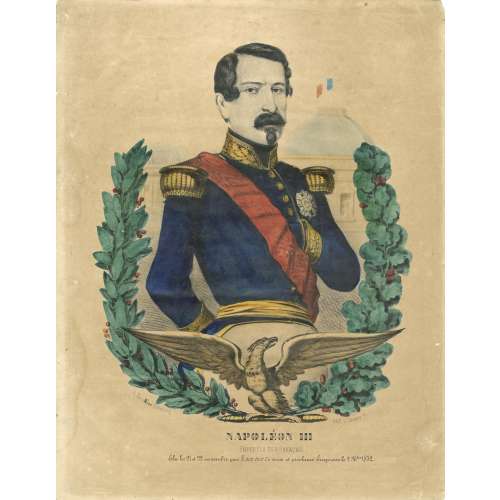 Hand-coloured lithography on wove paper, 380 x 298 mm; black ink stamp “4912” to reverse. On stone left: "A, Paris Miné Éditeur, imp.;" right: "Lith. R. St. Jacques. 41." Bottom center: "Napoléon III"; below: "EMPEREUR DES FRANÇAIS", under: "Élu les 21 el 22 novembre par 8,000,000 de voix et proclamé Empereur le 2 Xbre 1852." Printer/publisher: Miné, éditeur, imprimeur en lithographie, Rue Saint-Jacques, 41. Napoleon III [Charles-Louis Napoléon Bonaparte] (French, 1808 – 1873)
Hand-coloured lithography on wove paper, 380 x 298 mm; black ink stamp “4912” to reverse. On stone left: "A, Paris Miné Éditeur, imp.;" right: "Lith. R. St. Jacques. 41." Bottom center: "Napoléon III"; below: "EMPEREUR DES FRANÇAIS", under: "Élu les 21 el 22 novembre par 8,000,000 de voix et proclamé Empereur le 2 Xbre 1852." Printer/publisher: Miné, éditeur, imprimeur en lithographie, Rue Saint-Jacques, 41. Napoleon III [Charles-Louis Napoléon Bonaparte] (French, 1808 – 1873) -
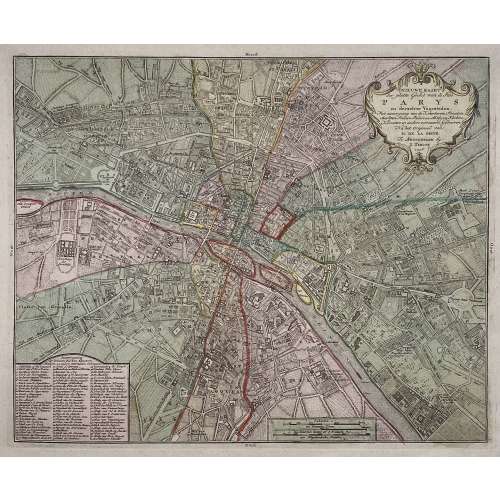
Title: NIEUWE KAART | der platte Grond van de Stad | PARYS | en derzelver Voorsteden. | Met aanwyzing van de Kwartieren, Staaten, | Markten, Pleinen, Paleizen, Abtyden, Kerken, | Kloosters en andere voornaame Gebouwen. | Na het Origineel van | M. DE LA GRIVE. | Te Amsterdam by | I. Tirion. | 1756. ||
Author : Jean Delagrive (French, 1689-1757)
Publisher: Isaak Tirion (Dutch, 1705 – 1765)
Publication date: 1756.
Dimensions: Sheet: 42.5 x 53.8 cm; Image: 30.7 x 37.7 cm.
Plate № 59 from Beknopte Atlas van omtrent honderd platte gronden der voornaamste vestingen, kasteelen en Steden van Europa. -
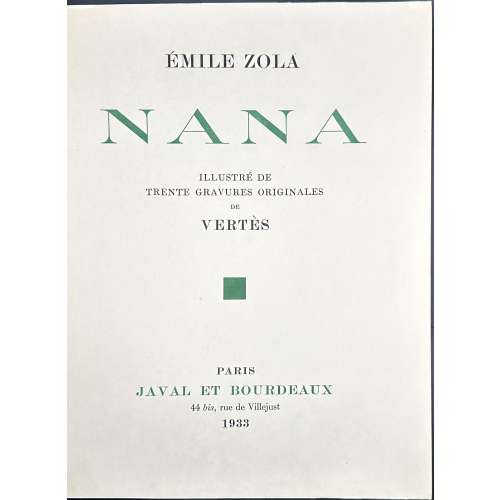 Publisher’s olive French flapped wrappers, in-4to, 33 x 25.3 x 6 cm, green and black lettering to front and spine, in a glassine dust jacket, in a marbled double slipcase 34.5 x 25.5 cm, unbound; pp.: [8] 1-436 [4], plus 30 colour plates with guard tissue, extraneous to collation; edition enriched with a set of 30 uncoloured etchings with guard tissue in a lettered paper folder. Title-page: ÉMILE ZOLA | NANA | ILLUSTRÉ DE | TRENTE GRAVURES ORIGINALES | DE | VERTÈS |◾| PARIS | JAVAL ET BOURDEAUX | 44 bis, rue de Villejust | 1933 || Justification du tirage: il a été tiré de «Nana » d'Émile Zola. Soixante exemplaires sur japon impérial, numérotés de 1 a 60, avec un état en couleurs colorié a la main et un état en noir des trente gravures originales de Vertès. [Edition limited to 60 copies, this is copy № 54]. Colophon: « NANA », D'ÉMILE ZOLA, ÉTÉ ACHEVÉ D'IMPRIMER LE TRENTE AVRIL MIL NEUF CENT TRENTE-TROIS, EN CARACTÈRES ROMAIN ANGLAIS DU CORPS 16, SUR LES PRESSES DU MAITRE IMPRIMEUR COULOUMA, À ARGENTEUIL, H. BARTHÉLEMY, DIRECTEUR. LES COMPOSITIONS DE VERTÈS ONT ÉTÉ REPRODUITES EN FAC-SIMILÉ PAR D. JACOMET & Cie. Printed on April 30, 1933 by Coulouma in Argenteuil, H. Barthélemy, director; illustrations reproduced in facsimile by D. Jacomet & Co. Catalogue raisonné: Vokaer 30. Contributors: Émile Zola (French, 1840 – 1902) – author. Marcel Vertès [Marcell Vértes] (Jewish-Hungarian-French, 1895 – 1961) – artist. Javal et Bourdeaux – publisher. Daniel Jacomet (French, 1894 – 1966) – printer. Seller's description: Nana. Paris, Javal et Bourdeaux, 1933. 2 volumes in-4, en feuilles, non coupé, non rogné, chemise et étui. Ouvrage illustré de 30 gravures originales en couleurs de Marcel Vertès. Tirage à 60 exemplaires sur japon impérial contenant un état des illustrations coloriées à la main en couleurs et un état en noir. Chemise et emboîtage insolés.
Publisher’s olive French flapped wrappers, in-4to, 33 x 25.3 x 6 cm, green and black lettering to front and spine, in a glassine dust jacket, in a marbled double slipcase 34.5 x 25.5 cm, unbound; pp.: [8] 1-436 [4], plus 30 colour plates with guard tissue, extraneous to collation; edition enriched with a set of 30 uncoloured etchings with guard tissue in a lettered paper folder. Title-page: ÉMILE ZOLA | NANA | ILLUSTRÉ DE | TRENTE GRAVURES ORIGINALES | DE | VERTÈS |◾| PARIS | JAVAL ET BOURDEAUX | 44 bis, rue de Villejust | 1933 || Justification du tirage: il a été tiré de «Nana » d'Émile Zola. Soixante exemplaires sur japon impérial, numérotés de 1 a 60, avec un état en couleurs colorié a la main et un état en noir des trente gravures originales de Vertès. [Edition limited to 60 copies, this is copy № 54]. Colophon: « NANA », D'ÉMILE ZOLA, ÉTÉ ACHEVÉ D'IMPRIMER LE TRENTE AVRIL MIL NEUF CENT TRENTE-TROIS, EN CARACTÈRES ROMAIN ANGLAIS DU CORPS 16, SUR LES PRESSES DU MAITRE IMPRIMEUR COULOUMA, À ARGENTEUIL, H. BARTHÉLEMY, DIRECTEUR. LES COMPOSITIONS DE VERTÈS ONT ÉTÉ REPRODUITES EN FAC-SIMILÉ PAR D. JACOMET & Cie. Printed on April 30, 1933 by Coulouma in Argenteuil, H. Barthélemy, director; illustrations reproduced in facsimile by D. Jacomet & Co. Catalogue raisonné: Vokaer 30. Contributors: Émile Zola (French, 1840 – 1902) – author. Marcel Vertès [Marcell Vértes] (Jewish-Hungarian-French, 1895 – 1961) – artist. Javal et Bourdeaux – publisher. Daniel Jacomet (French, 1894 – 1966) – printer. Seller's description: Nana. Paris, Javal et Bourdeaux, 1933. 2 volumes in-4, en feuilles, non coupé, non rogné, chemise et étui. Ouvrage illustré de 30 gravures originales en couleurs de Marcel Vertès. Tirage à 60 exemplaires sur japon impérial contenant un état des illustrations coloriées à la main en couleurs et un état en noir. Chemise et emboîtage insolés. -
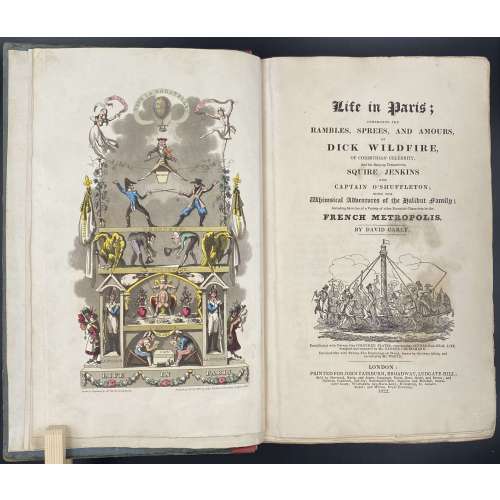
Title: Life in Paris ; | COMPRISING THE | RAMBLES, SPREES, AND AMOURS, | OF | DICK WILDFIRE, | OF CORINTHIAN CELEBRITY, | And his Bang-up Companions, SQUARE JENKINS | AND | CAPTAIN O’SHUFFLETON ; | WITH THE | Whimsical Adventures of the Halibut family ; | Including Sketches of a Variety of other Eccentric Characters in the | FRENCH METROPOLIS. | BY DAVID CAREY |[Vignette]| Embellished with Twenty-One COLOURED PLATES, representing SCENES from REAL LIFE, | designed and engraved by Mr. GEORGE CRUIKSHANK. | Enriched also with Twenty-Two Engravings on Wood, drawn by the same Artist, and | executed by Mr. WHITE. | LONDON : | PRINTED FOR JOHN FAIRBURN, BROADWAY, LUDGATE HILL; | Sold by Sherwood, Neely, and Jones ; Langman, Hurst, Rees, Orme, and Brown ; and | Baldwin, Craddoc, and Joy ; Paternoster-Row ; Simpkin and Marshall, Statio- | ners’ Court ; Whittakers Ave-Maria-Lane ; Humphrey, St. James’s | Street ; and Wilson, Royal Exchange. | 1822. ||
Edition: 1st edition in book form, 1st issue; large-paper copy bound from the parts in original blue paper boards, "most scarce" (Cohn).
Pagination: ffl, [i, ii] – h.t. ‘LIFE IN PARIS’ / ‘MARCHANT, Printer, Ingram-Court, London’, [2] – blank / Frontispiece (Ville la Bagatelle!!) hand-coloured, [iii, iv] – t.p. with vignette / blank, [v] vi-xxiv, [1] 2-489 [490 blank], [2] – 'TO THE BINDER' and 'Marchant, Printer, Ingram-Court, Fenchurch Street' "considered indispensable to a complete copy" (Cohn) / blank, bfl watermarked 1800; 21 hand-coloured aquatints and 22 wood-engraved text vignettes; cancelled leaves 143/4 and 335/6; pinholes from printing visible in most gatherings.
Collation: 4to; [a]-c4, B-Z4 Aa-Zz4 3A-3Q4 3R1 + [Ω]1
Binding: Original boards sometime re-backed with red paper, binder's end leaf watermarked 1800; red hard-grained morocco clamshell box.
Catalogue raisonné: Albert M. Cohn, 1924: № 109 p. 37/8; Abbey, J. R. (Life in England), 112; Tooley (Some English Books with Coloured Plates) 129; Hardie (English coloured books) 199.
Description of Shapero Rare Books, London: Of the copies that have come to auction since 1975 only one has been a large-paper copy in original boards. "The pictures are extremely spirited and true and are all the more wonderful in view of the fact that the artist’s continental experiences were limited to one day spent in Boulogne." (Hardie). In 1821, the journalist Pierce Egan published Life in London, an immediate success illustrated by the Cruikshank brothers, George and Robert. In order to capitalise on this success, another journalist, David Carey, decided to publish his own Life in Paris in monthly instalments (just like Life in London) and with a very similar frontispiece to the one that appears in Egan’s work; Life in Paris, however, was illustrated only by George Cruikshank. One of the earliest and most notable examples of the work of George Cruikshank, with fine, clean plates.


